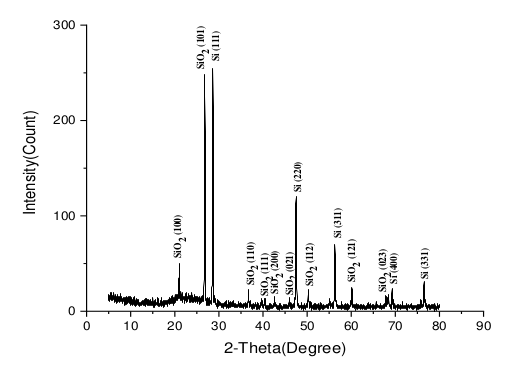Isolation and Characterisation of High Grade Nanosilicon from Coastal Landform in Ilaje Local Government Area of Ondo State, Nigeria.
Keywords:
Coastal landform, Magnesiothermic reduction, Nanosilicon, CharacterisationAbstract
The application of silicon and silicon based materials in industries and optoelectronic devices cannot be over emphasized due to their unique properties. The availability of high grade silicon has been subject of interest for manufacturers and industrialist as the material has from discovery been very much insufficient to cater for the numerous demands for different uses and utilization. Numerous efforts have been put together to adapt the properties of silicon through the manufacture and fabrication of semiconductor compounds to replace silicon in functionality. Notwithstanding, the quest for more silicon in the environment is yet unabated. This research centers on the isolation and characterisation of high grade nanosilicon from coastal landform in Ilaje Local Government Area of Ondo State, Nigeria due to the attractive nature of the landforms in terms of colour and texture. Sand from the selected study area were categorised into different forms according to their colour and silicon isolated using the magnesiothermic reduction while the nanosilicon was obtained using an appropriate ball milling process. The morphology of nanosilicon from Zion, Micheal-Ugbonla, and Oluwa Glass coastal landforms shows an agglomeration of particles with irregular shapes having average particle sizes of 58.98 nm, 77.82 nm, and 37.27 nm, respectively. The XRD spectra of the nanosilicon showed sharp, distinct peaks that indicate crystallinity of the samples. The percentages of nanosilicon value obtained ranges from 65.23%-80.30% and considered high enough to find specific useful industrial applications in lithium ion batteries, biomedical devices, opto electronic device utilization and computer industries.

Published
How to Cite
Issue
Section
Copyright (c) 2023 S. S. Oluyamo, O. F. Famutimi, M. O. Olasoji

This work is licensed under a Creative Commons Attribution 4.0 International License.
How to Cite
Similar Articles
- M. M. Tanko, M. S. Liman, W. L. Lumbi, U. S. Aliyu, Spatial and Seasonal Estimation of Tropospheric Radio Refractivity in Nigeria , African Scientific Reports: Volume 1, Issue 1, April 2022
- I. M. Echi, E. V. Tikyaa, E. J. Eweh, A. A. Tyovenda, T. Igbawua, Investigation of the spatial distribution of deterministic chaos in some meteorological variables across Nigeria , African Scientific Reports: Volume 4, Issue 2, August 2025
- Matthew Onyema Agu, Umar Kyakyaidi, Collins Chibuzor Odidika, Inya Inya Agha, Physical quality assessment of selected made in Nigeria synthetic surfactants for surface activity in Bali, Taraba State, Nigeria , African Scientific Reports: Volume 3, Issue 1, April 2024
- Samson A. Aasa, Regan K. Dunne, Dawood A. Desai, Aspect ratio of thermo-hydraulic performance of periodically prescribed semi-circular groove in rectangular channel , African Scientific Reports: Volume 4, Issue 3, December 2025 (In Progress)
- S. M. Shiada, S. D. Igba, O. Shiekar, E. A. Damian, Simulation of the influence of cloud density on the removal of particulate matter and gaseous pollutants at the Dangote cement factory by rain , African Scientific Reports: Volume 4, Issue 2, August 2025
- Shamsuddeen Sani Alhassan, Mahmud Abdulsalam, Abdullahi Tanimu, Ibrahim Muhammad Bagudo, Role of Van der Waals correction on the catalytic performance of 1T-TiS₂ electrocatalyst , African Scientific Reports: Volume 4, Issue 3, December 2025 (In Progress)
You may also start an advanced similarity search for this article.




